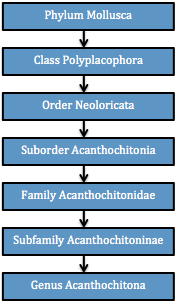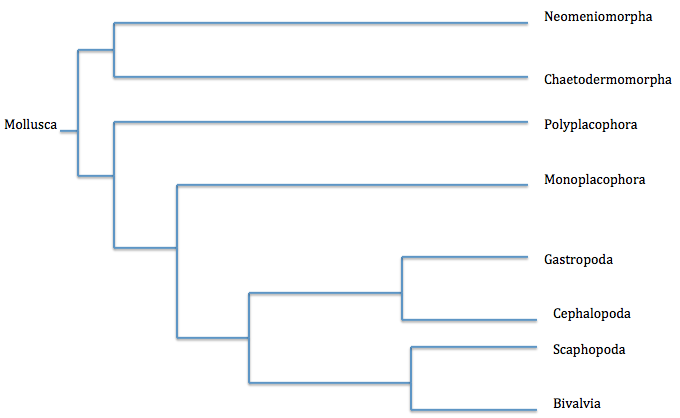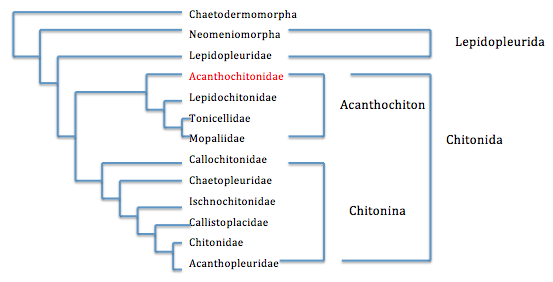Summary
Physical Description
Size
Description
Identification resources
Distribution and Ecology
Local distribution and microhabitat
Biogeographical distribution
Life History & Behaviour
Behaviour and locomotion
Reproduction
Feeding
Respiration
Anatomy & Physiology
External Morphology
Internal Anatomy
Evolution & Systematics
Fossil History
Phylogenetics
Conservation & Threats
References & Links
Reference List | Phylogenetics
Below is the systematics of Acanthochitona sp. (Figure 1). For more information and a description of these taxonomic ranks, see Identification Resources.
 Figure 1:
Figure 1: Systematics of Acanthochitona sp., from Phylum down to genus.
Within Mollusca, apalcophorans, which are shell-less molluscs, are most likely the most basal group and most closely related to the molluscan ancestor. Eumollusca involves all the other molluscs except for apalcophorans and includes polyplacophorans. Mollusca then split into polyplacohporans and all other molluscs. Therefore polyplacophorans appear to be the next most basal molluscan group, which evolved the characteristic eight valves seen today (Figure 2). It is most likely that both Polyplacophora and Monoplacophora (that have one shell) evolved from a shell-less ancestor as there is no evidence that polyplacphorans and monoplacophorans evolved from each other, as that would have involved segmentation of a single shell (polyplacophorans) or by a process of loosing seven shell plates (monoplacophorans) (Ruppert et al 2004).
 Figure 2: A proposed phylogeny of the phylum Mollusca, adapted from Ruppert et al 2004.
Valve, radula, sperm, egg and gill morphology and molecular data have all been useful characteristics to determine the phylogency within polyplacophora (Schwabe 2010, Buckland-Nicks 2008, Okusu et al 2003). Using morphological characteristics, a phylogeny was proposed for polyplacophora (Figure 3). It demonstrates that polyplacophora has two clades, Chitonida and Lepidopleurida. Within Chitonida is the suborder Acanthochitonina, with its sister group, the suborder Chitonina. Acanthochitonina is characterised as having abanal gills with cupsules on the egg hull while Chitonina have adanal gills (Okusu et al 2003). Acanthochitonidae appears to be the most basal family within Acanthochitonina (Figure 3). Although, there has been some debate against this phylogeny using DNA analysis and the monophylogeny within Acanthochitonina is still unclear (Okusu et al 2003).
 Figure 3:
Figure 3: Phylogentic tree of polyplacophoran families based on morphological characteristics such as sperm, egg, valve, gill and girdle morphology, adapted from Buckland-Nicks 1995. |
|